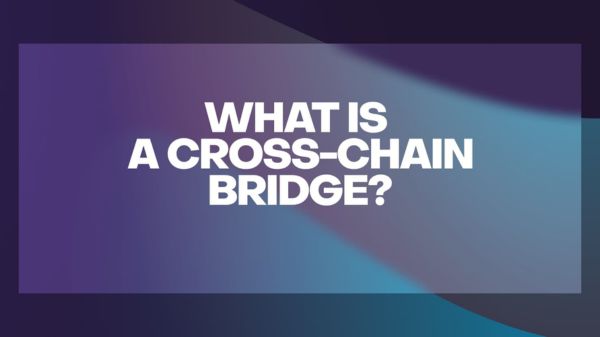In the rapidly evolving landscape of cryptocurrencies, achieving seamless interoperability between blockchain networks has become crucial. Cross-chain bridges have emerged as a fundamental technology, enabling the transfer of digital assets and data across different blockchain ecosystems. This article will delve into the concept of cross-chain bridges, explore how they work, and highlight the top Cross-chain bridges driving the industry forward. Additionally, we will discuss the safety considerations when using cross-chain bridges.
Table of Contents
Top Cross-Chain Bridges

Binance Bridge
Binance Bridge is a prominent cross-chain solution offered by Binance, one of the leading cryptocurrency exchanges. It enables the seamless transfer of assets between Binance Smart Chain (BSC) and other supported blockchains, such as Ethereum. Binance Bridge has gained popularity due to its efficiency, low transaction fees, and extensive asset support.
Multichain Bridge
Multichain Bridge is a decentralized cross-chain bridge that aims to connect multiple blockchain networks. It supports interoperability between chains like Ethereum, Binance Smart Chain, Avalanche, and more. Multichain Bridge offers fast transaction speeds and supports various asset transfers, including tokens, NFTs, and wrapped assets.
Arbitrum Bridge
Arbitrum Bridge is a layer 2 scaling solution for Ethereum that enables cross-chain transfers. It provides faster and cheaper transactions by utilizing sidechains. The bridge allows users to move assets between Ethereum and the Arbitrum network, unlocking enhanced scalability while retaining compatibility with the Ethereum ecosystem.
Polygon Bridge
Polygon Bridge, built on the Polygon (formerly Matic) network, focuses on enhancing interoperability for Ethereum-based assets. It enables users to transfer assets between Ethereum and the Polygon network quickly and efficiently. Polygon Bridge contributes to the overall scalability and usability of the Ethereum ecosystem.
Synapse Bridge
Synapse Bridge is a cross-chain bridge that connects different blockchain networks, including Ethereum and Binance Smart Chain. It offers a user-friendly interface and supports seamless asset transfers between the interconnected chains. Synapse Bridge aims to simplify cross-chain operations for both developers and end-users.
Tezos Wrap Protocol Bridge
The Tezos Wrap Protocol Bridge provides a means to transfer assets between Tezos and Ethereum. It enables Tezos tokens to be wrapped as ERC-20 tokens, allowing them to be utilized within the Ethereum ecosystem. The bridge enhances liquidity and opens up new possibilities for cross-chain interactions involving Tezos.
Portal Token Bridge
The Portal Token Bridge is a cross-chain bridge designed to connect different blockchain networks, including Ethereum, Binance Smart Chain, and Avalanche. It supports the transfer of various digital assets, including tokens and NFTs. The bridge offers a secure and efficient way to achieve cross-chain interoperability.
Avalanche Bridge
The Avalanche Bridge facilitates the seamless transfer of assets between Avalanche and Ethereum. It enables users to transfer tokens, NFTs, and other assets between the two networks, unlocking new possibilities for decentralized applications and financial interactions.
How Do Crypto Bridges Work?
Cross-chain bridges typically function through a combination of smart contracts and decentralized protocols. When a user wants to transfer assets from one blockchain to another, they deposit their assets into the bridge's smart contract on the source blockchain. The smart contract locks the assets, creating a representation or token on the source chain. This representation is then transferred to the destination blockchain through a secure communication channel established by the bridge. Once the assets arrive on the destination blockchain, the user can access and utilize them as desired. The bridge's smart contract ensures the security and integrity of the entire process.

What assets does Cross-Chain Bridges support?
The assets supported by cross-chain bridges can vary depending on the specific bridge and the blockchain networks it connects. However, many cross-chain bridges aim to support a wide range of assets to facilitate interoperability between different blockchains. Some of the commonly supported assets include:
-
Cryptocurrencies: Cross-chain bridges often support popular cryptocurrencies such as Bitcoin (BTC), Ethereum (ETH), Litecoin (LTC), Ripple (XRP), and others. These bridges enable the transfer of these assets between different blockchain networks.
-
Stablecoins: Stablecoins, which are cryptocurrencies pegged to a stable asset like fiat currency (e.g., USD), are frequently supported by cross-chain bridges. Examples include Tether (USDT), USD Coin (USDC), Dai (DAI), and others. These stablecoins enable users to transfer value between blockchains without the volatility associated with other cryptocurrencies.
-
ERC-20 Tokens: ERC-20 is a token standard on the Ethereum blockchain, and many cross-chain bridges provide support for transferring ERC-20 tokens to other blockchains. This support expands the reach and accessibility of various decentralized finance (DeFi) tokens and utility tokens.
-
BEP-20 Tokens: BEP-20 is a token standard on the Binance Smart Chain (BSC). Cross-chain bridges may also facilitate the transfer of BEP-20 tokens, allowing users to bridge their assets between BSC and other blockchains.
-
NFTs: Non-Fungible Tokens (NFTs) represent unique digital assets, and some cross-chain bridges offer support for transferring NFTs between different blockchain networks. This enables users to move their NFTs across various platforms and ecosystems.
It's important to note that the specific assets supported by a cross-chain bridge can vary. The bridge's documentation or website should provide information on the supported assets and the available cross-chain routes. Before using a cross-chain bridge, it's recommended to verify the supported assets and ensure that the assets you intend to transfer are compatible with the bridge.
Are Crypto Bridges Safe?
While cross-chain bridges have proven to be effective in enabling interoperability, it is essential to consider the safety aspects. When using a cross-chain bridge, users should verify the bridge's security measures, such as audits, reputation, and community trust. It is advisable to conduct thorough research and exercise caution when interacting with any decentralized application or smart contract-based system.
Cost of using Cross-Chain Bridges
The cost of using cross-chain bridges can vary depending on several factors:
-
1. Transaction fees: When using cross-chain bridges, you will typically incur transaction fees for transferring assets between different blockchains. These fees can vary based on the specific bridge you are using and the blockchain networks involved. Each blockchain may have its own fee structure, which can include network gas fees or other transaction costs.
-
2. Network congestion: During periods of high network congestion, such as when there is heavy demand or increased activity on a particular blockchain, transaction fees may increase. This can affect the cost of using cross-chain bridges as well. If the bridge operates on a congested blockchain, you may have to pay higher fees to ensure your transactions are processed in a timely manner.
-
3. Exchange rates: When transferring assets between different blockchains using cross-chain bridges, there may be exchange rate costs involved. These costs can be influenced by market fluctuations and the liquidity of the assets being transferred. It's important to consider these exchange rate costs, especially when dealing with volatile or illiquid assets.
-
4. Bridge-specific fees: Some cross-chain bridges may charge additional fees for their services. These fees can vary depending on the bridge provider and the features offered. For example, a bridge may have a subscription or usage-based fee structure, or it may charge a percentage of the transaction value as a fee.
-
5. Third-party fees: In addition to the fees charged by the cross-chain bridge itself, there may be fees imposed by third-party services or platforms involved in the process. For example, if you're using a decentralized exchange (DEX) on the destination blockchain, there may be fees associated with the trading or liquidity provision on that platform.
It's important to research and consider these various cost factors when using cross-chain bridges. Different bridges and blockchain networks may have different fee structures and cost considerations. It's advisable to review the documentation and fee schedules provided by the specific cross-chain bridge you intend to use to understand the costs involved.

How to use top Cross-Chain Bridges
To use top cross-chain bridges, you generally need to follow these steps:
-
1. Research and choose a cross-chain bridge: Identify the top cross-chain bridges available in the market based on your specific requirements and the blockchains you want to connect. Consider factors such as supported assets, fees, security, and community support.
-
2. Set up wallets: Ensure you have wallets compatible with the blockchains involved in the cross-chain transfer. For example, if you want to transfer assets from Ethereum to Binance Smart Chain, you'll need an Ethereum wallet (e.g., MetaMask) and a Binance Smart Chain wallet (e.g., Trust Wallet).
-
3. Connect and configure wallets: Connect your wallets to the respective blockchain networks and configure them to support the cross-chain bridge. This typically involves adding the relevant network or custom RPC settings to your wallet.
-
4. Select the asset and destination: Choose the asset you want to transfer and select the destination blockchain network. For example, if you have ETH on Ethereum and want to transfer it to Binance Smart Chain, you'll specify the amount of ETH and select Binance Smart Chain as the destination.
-
5. Connect to the cross-chain bridge: Access the website or platform of the chosen cross-chain bridge. Connect your wallet to the bridge interface, ensuring you are using the correct wallet for the source blockchain.
-
6. Initiate the transfer: Follow the instructions provided by the cross-chain bridge to initiate the transfer. This typically involves specifying the source asset, amount, and destination address on the target blockchain.
-
7. Confirm and wait for confirmation: Review the transaction details, including fees and gas limits, and confirm the transfer. Once confirmed, the cross-chain bridge will initiate the transfer process. Wait for the transfer to be processed and confirmed on both the source and destination blockchains. This may take some time depending on network congestion and confirmation requirements.
-
8. Verify the transfer: Once the transfer is completed, verify that the assets have arrived on the destination blockchain. You can check the transaction details on the respective block explorers for both blockchains.
It's important to note that the specific steps may vary depending on the cross-chain bridge you choose and the blockchains involved. Always refer to the documentation and guidelines provided by the bridge to ensure you follow the correct process. Additionally, exercise caution, double-check addresses, and be mindful of fees and gas limits during the transfer process.
Some Notes When Using Cross-Chain Bridges
Verify the legitimacy and security of the cross-chain bridge before using it.
Ensure you are using the correct bridge for the intended blockchain networks.
Double-check the asset addresses and destination networks during the transfer process.
Consider the transaction fees and processing times when choosing a cross-chain bridge.
Stay informed about the latest updates and developments in the cross-chain bridge ecosystem.
Conclusion
Cross-chain bridges have emerged as powerful tools for achieving interoperability in the cryptocurrency world. They enable seamless asset transfers between different blockchain networks, expanding the possibilities and utility of cryptocurrencies. The top cross-chain bridges discussed in this article, such as Binance Bridge, Multichain Bridge, and Arbitrum Bridge, play a crucial role in driving the industry forward. However, it is important to exercise caution and perform due diligence when using cross-chain bridges to ensure the safety and security of your assets in the evolving decentralized landscape. Let's go with U2U to follow the latest information on the market.






